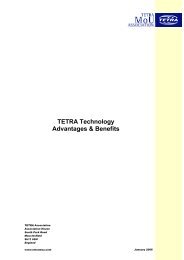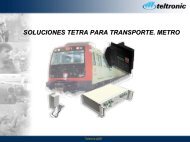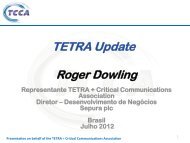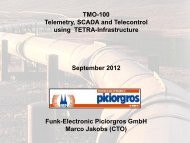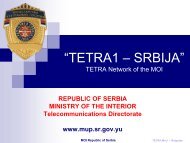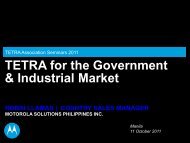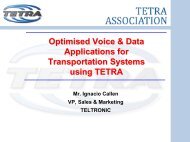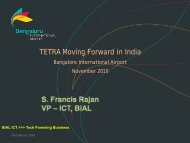What are the technical options - tetra
What are the technical options - tetra
What are the technical options - tetra
Create successful ePaper yourself
Turn your PDF publications into a flip-book with our unique Google optimized e-Paper software.
TECHNOLOGY OPTIONS FOR<br />
BROADBAND<br />
David Chater-Lea<br />
Chairman, TC TETRA WG4<br />
Vice Chairman, TC TETRA WG6<br />
Broadband Critical Communications<br />
Conference<br />
14-15 February 2012<br />
© ETSI 2012. All rights reserved
Who <strong>are</strong> we<br />
European Telecommunications<br />
Standards Institute<br />
Technical committees<br />
TC TETRA<br />
Working groups<br />
WG1<br />
User<br />
requirements<br />
WG3<br />
Protocols<br />
WG4<br />
Data, high speed and<br />
advanced air<br />
interfaces<br />
WG5<br />
Speech codec<br />
WG6<br />
Security<br />
WG8<br />
Direct Mode
Requirements, technology and spectrum<br />
Technology is determined by:<br />
• Requirements – what do we have to do<br />
• Spectrum – where can we put <strong>the</strong> technology<br />
It’s a circular discussion:<br />
• <strong>What</strong> is a technology capable of<br />
• Is it compatible with o<strong>the</strong>r technologies, in <strong>the</strong> same spectrum<br />
• The technology and requirements dictate <strong>the</strong> spectrum requirements<br />
Requirements<br />
Spectrum<br />
Technology
Impact of Requirements<br />
Requirements have impacts on parameters:<br />
• Bandwidth per user, and bandwidth for <strong>the</strong> whole cell<br />
• Group or individual communications<br />
• Number of users per cell<br />
• Prioritisation and quality of service<br />
• Nature of communications – data, video, voice<br />
Exercise to quantify <strong>the</strong> requirements from PPDR users is currently<br />
ongoing<br />
• LEWP RCEG – TC TETRA WG4 – TCCA Applications group
Analysis of <strong>the</strong> LEWP matrix<br />
WG4 <strong>are</strong> working with <strong>the</strong> LEWP to put real numbers to <strong>the</strong> matrix<br />
This will help justify <strong>the</strong> case for spectrum, as well as technology choices<br />
5
Technology decisions<br />
Any technology adopted for professional<br />
communications must be standards based<br />
• The professional mobile communications industry is too<br />
small to support several technologies<br />
• We need <strong>the</strong> total market size to support competition<br />
for pricing and functionality<br />
• We need <strong>the</strong> total market size to support <strong>the</strong> niche<br />
market products – ruggedised terminals, covert<br />
installations, ATEX products etc.<br />
Design a technology standard ourselves, or pick up an<br />
existing standard<br />
• The greatest investments in wireless technology<br />
development come from <strong>the</strong> Cellular operator and<br />
Internet industries<br />
• Driven by growth in data communications, and need to<br />
drive down <strong>the</strong> cost of data service<br />
• Our industry cannot match <strong>the</strong> level of investment, if we<br />
want an equivalent broadband standard
Technology <strong>options</strong><br />
Develop and standardise a fresh technology within our own industry<br />
Take an existing standard from elsewhere and use ‘as is’<br />
Take an existing standard, and modify for suitability<br />
Areas where an existing Public Mobile standard may need development:<br />
• Group communications – voice and data<br />
• Prioritisation amongst users and groups<br />
• Security<br />
• Interworking with existing narrowband standards (TETRA etc)<br />
Issue: we <strong>are</strong> a small voice comp<strong>are</strong>d to<br />
<strong>the</strong> size of <strong>the</strong> commercial cellular market<br />
Approx 3 million terminals sold vs<br />
5 billion active subscriptions....
Wideband Technologies<br />
Narrowband – wideband technologies – TEDS<br />
• Designed to fit into existing spectrum without interference to adjacent users<br />
• Tradeoff range vs capacity; can match or exceed range of TETRA 1 cell<br />
• Easy to adapt to group communications<br />
• Capable of hundreds of kbps<br />
Techniques from o<strong>the</strong>r industries can be used to increase throughput/range<br />
TEDS enhancements<br />
<strong>are</strong> possible<br />
Error corrected Rate<br />
400 kb/s<br />
WG4 <strong>are</strong> working on<br />
improvements to TEDS<br />
already<br />
300 kb/s<br />
200 kb/s<br />
100 kb/s<br />
50 kb/s<br />
15 kb/s<br />
150<br />
kHz<br />
100<br />
kHz<br />
50 kHz<br />
25 kHz<br />
TETRA 1<br />
Range
Broadband technologies<br />
All require separate spectrum from narrowband because of interference<br />
issues<br />
• Guard bands needed at band edges for protection<br />
• Transmitter and receiver issue<br />
Broadband technology in use today<br />
• CDMA (Code Division Multiple Access)<br />
• CDMA 1x EV-DO<br />
• Wideband CDMA – UMTS (HSPA etc)<br />
• OFDMA (Orthogonal Frequency Division Multiple Access)<br />
• LTE<br />
• WiMax<br />
OFDMA technologies <strong>are</strong> replacing CDMA technologies in <strong>the</strong> Cellular world<br />
• Better data throughputs with better spectral efficiency
LTE technologies<br />
Adaptive Modulation and Coding<br />
up to 64QAM<br />
Multiple-Input Multiple-Output<br />
Orthogonal Frequency<br />
Division Multiple Access<br />
System Bandwidth<br />
Sub-carriers<br />
Single-Carrier Frequency<br />
Division Multiple Access<br />
System Bandwidth<br />
Sub-frame<br />
Sub-frame<br />
Single Carrier<br />
Frequency<br />
Frequency<br />
Time frequency<br />
resource for User 1<br />
Time frequency<br />
resource for User 1<br />
Time<br />
Time frequency<br />
resource for User 2<br />
Time frequency<br />
resource for User 3<br />
Time<br />
Time frequency<br />
resource for User 2<br />
Time frequency<br />
resource for User 3<br />
0
Can we mix and match from o<strong>the</strong>r standards<br />
Can we build TETRA services by using some of <strong>the</strong> layers existing broadband<br />
standard such as LTE<br />
Mobility<br />
Mgmt<br />
Cct mode<br />
Mobile Link Entity<br />
Logical Link Control<br />
User IP<br />
SNDCP<br />
User IP<br />
Higher layer<br />
control<br />
Radio Resource<br />
Control<br />
Packet data convergence protocol<br />
Radio Link Control<br />
MAC – error correction etc<br />
Physical layer - radio<br />
MAC – error correction etc<br />
Physical layer - radio<br />
But if we did, could we implement it – would chips be available
Alternative ‘application’ approach<br />
Can we standardise TETRA services as ‘applications’ operating over ano<strong>the</strong>r<br />
standard using IP<br />
Mobility<br />
Mgmt<br />
Cct mode<br />
Gateway<br />
User IP<br />
SNDCP<br />
User IP<br />
Higher layer<br />
control<br />
Radio Resource<br />
Control<br />
Packet data convergence protocol<br />
Radio Link Control<br />
<br />
Several approaches could be<br />
followed:<br />
‘Package’ TETRA services and<br />
use <strong>the</strong> IP service of <strong>the</strong><br />
broadband standard<br />
<br />
<br />
Use an available service (e.g.<br />
based on IMS, SIP, PoC, or....)<br />
and standardise a gateway<br />
interface<br />
Add End to end security<br />
MAC – error correction etc<br />
Physical layer - radio<br />
<br />
NB: underlying protocols must<br />
support all <strong>the</strong> required<br />
services!
Can LTE be used in <strong>the</strong> professional<br />
communications market<br />
Already adopted in <strong>the</strong> USA for data, operating toge<strong>the</strong>r with APCO Project<br />
25 voice and narrowband data equipment<br />
Good spectrum efficiency<br />
• Reuse same frequencies on every site<br />
High capacity<br />
Spectrum – needs separation from existing narrowband equipment<br />
• 1 MHz guardbands chosen in <strong>the</strong> US<br />
Should we adopt it as a ‘standard’ for <strong>the</strong> professional mobile radio market<br />
as is<br />
• Data only for sure – depends on developments for voice
Tradeoffs when using commercial<br />
cellular technology<br />
Positives:<br />
• Access to technology developed<br />
from high levels of investment<br />
• Rapid technology development<br />
• Fundamental chipsets available<br />
• Reuse of commercial applications<br />
Areas for caution:<br />
Fast development roadmap vs a conservative<br />
industry – danger of obselesence<br />
GSM-R serves as an illustration<br />
Reuse of technology doesn’t mean use of<br />
commercial terminals<br />
<br />
Consumer terminal suppliers will not load <strong>the</strong> cost of<br />
additional bands into mass market terminals<br />
Performance can be frequency band<br />
dependent – may not realise all of <strong>the</strong><br />
benefits<br />
Coverage and capacity need c<strong>are</strong>ful attention<br />
May be difficult to influence changes in a<br />
standard, even if requirements <strong>are</strong><br />
presented:<br />
<br />
<br />
E.g. need a common interest to provide group call<br />
service<br />
DMO
Where do we go from here<br />
1. Complete <strong>the</strong> development of <strong>the</strong> requirements<br />
o Work out which applications can be carried with existing narrowband and<br />
wideband systems, and which need broadband<br />
o Use <strong>the</strong> numbers derived to reinforce <strong>the</strong> case for spectrum<br />
1. Continue TEDS development<br />
o Range/throughput improvements, such as Alamouti coding<br />
o (Use of two transmit antennas at base station)<br />
o Efficiency improvements at <strong>the</strong> protocol level<br />
o Consider whe<strong>the</strong>r any fur<strong>the</strong>r TEDS channels <strong>are</strong> needed<br />
o >150kHz Multiple channels simultaneously<br />
1. Continue <strong>the</strong> development of broadband<br />
o Current work item running to 2015<br />
o Actively looking at LTE as <strong>the</strong> base technology<br />
o Will need to decide how it can be used
THANK YOU.<br />
QUESTIONS<br />
www.etsi.org<br />
© ETSI 2012. All rights reserved





